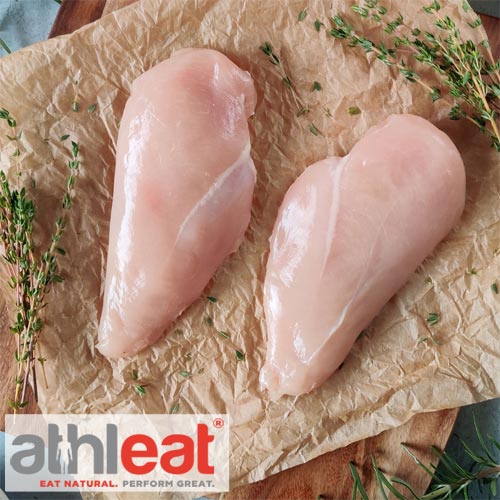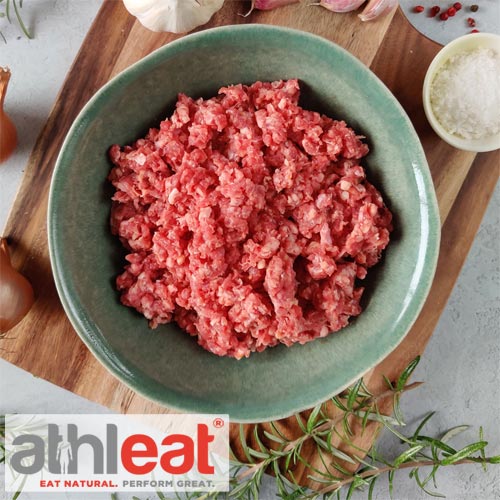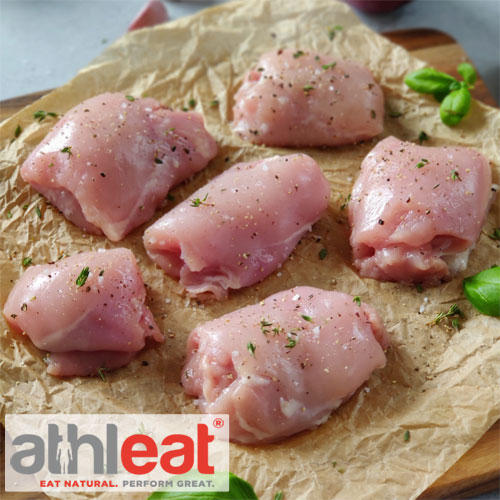Have you ever wondered how the cattle that produces the beef you eat is reared?
The truth is that many of us never ask that question… and by not doing so, we’re not really paying attention to what it is we’re putting into our bodies!
Surely you would rather eat beef that has not only come from cows that have been fed natural diets, but that have also been ethically reared (so it’s better for the animals and the environment too)?!
This is what makes grass-fed beef so great!
Grass-fed beef comes from animals that eat perennial grasses all their lives.
In contrast, grain-fed beef is what is most commonly sold in supermarkets.
While all cattle are grass-fed at some point in their lives, conventionally raised cows spend the majority of their lives feeding on corn and other grains, typically in a confined feedlot.
You will see that meat is often labelled “grass-fed” and this is not a lie, however many are then fed grain to fatten them up at the end of their life.
Fattening animals on grain produces meat that is lower in vitamins and minerals, omega 3 essential fatty acids and CLA (a type of naturally occurring trans-fatty acid that improves brain function, causes weight loss, and reduces your risk of cancer), while being higher in the highly inflammatory omega 6 fatty acids.
Grass-fed beef comes from cattle that has ultimately lived a life and been fed a diet as close to natural as possible…
It means they have lived in open pastures and eaten nothing but grass (supplemented by hay in the winter) and anything else they would find naturally and eat.
It also means they are not moved to barns and “finished” with grains or anything else to fatten them up for slaughter.
A happy, well-looked after cow means better quality meat!
There are other underlying factors of why grass-fed is good, so we have summarised both the key points and also those that are less likely to be in the forefront of our mind when buying our meat!
Grass-fed beef is better for you!
1. Animals that are grass-fed their entire lives are healthier and their meat is safer for us.
A ruminant’s gut is normally a pH-neutral environment, best suited to a diet of cellulosic grasses. It is not well suited to a diet of corn and other grains, the primary fare of feedlot cattle.
High in starch, low in roughage and a poor source of calcium and magnesium, corn upsets the cow’s stomach, making it unnaturally acidic.
Not only is this harmful to the cow (giving it a sort of bovine heartburn or, worse, making it very sick) but it allows a whole range of parasites and diseases to gain a foothold, including the pathogenic E. coli 0157:H7 bacterium!
Making its first appearance a little over 25 years ago, E. coli is now found in the intestines of most U.S. feedlot cattle. By acidifying a cow’s gut with corn, we have broken down one of our food chain’s barriers to infections.
Interestingly, this process can be reversed – switching a cow’s diet from corn to hay in the final days before slaughter reduces the population of E. coli in its manure by as much as 70 percent!
2. Grass-fed animals produce the right kind of fat.
Many people think of red meat as being “bad” for you and refuse to eat it at all, but it isn’t.
A well hung, grass-fed steak develops well-marbled flesh, and the fat within that marbling is packed full of good quality saturated fats because of the nature of their feed… Grass!
Fresh grass contains a high proportion (50-75 %) of total fatty acids. There are approximately 10 major fatty acids in grasses and, therefore, grass is the best choice of feed for most cows as well as other animals.
Grass-fed meat provides more omega-3 fats than some oily fish and, in addition to being higher in healthy omega-3s, meat from pastured cattle is also up to four times higher in vitamin E than meat from feedlot cattle, and much higher in CLA, a nutrient that is lacking in our diets.
3. It’s more nutritious in comparison to grain-fed beef.
In addition to producing the right kind of fat, grass-fed beef contains more nutrients when compared with its grain-fed cousins, including:
- Conjugated linoleic acid (not found in grain-fed beef), which is a type of fat that may prevent weight gain in humans
- More vitamin K2 (compared to grain-fed cattle), which important for heart health and bone health
- More antioxidants, especially vitamin E, which can help to bolster our immunity and fend off diseases
Grass-fed is also far better for the animals…
By choosing grass-fed beef, you are supporting the natural lifestyle of the cattle before they’re sent for slaughter…
This ultimately means happier cows and so better quality beef!
So, how is grass-fed better for the animals?
1. Pastured animals are treated more humanely.
From a humanitarian perspective, there is yet another advantage to pastured-animal products.
The cruelties of modern factory farming are severe, with livestock cooped up in cages barely larger than their own bodies, or packed together like sardines for months on end, standing knee-deep in their own manure. Pastured livestock are not forced to live in confinement and to endure the miseries of factory farming.
2. Grass-fed animals don’t need the large quantities of antibiotics that feedlot cattle do.
Most beef cattle spend their short life in concentrated animal feeding operations (CAFOs), where a thousand or more head of steer are kept in close, concentrated conditions and fattened up for slaughter as quickly as possible.
Since the 1950s, it has become routine practice to add low levels of antibiotics to the feed or water of healthy poultry, cattle, and swine to promote faster growth and prevent infections that tend to occur when animals are housed in crowded, unsanitary conditions.
The practice is now so common that, according to the FDA, which regulates the use of antibiotics in food animals, 80 percent (or the lion share) of antibiotics are used not in humans but in animals and most of those – an estimated 83 percent – are given to healthy animals, not to treat the sick ones!
Pastured cattle don’t require the drugs their CAFO’d cousins do. But again, a wise shopper should know that antibiotics are allowed for grass-fed cows, unlike their organic cousins, who generally are not allowed medicine when they develop a tickly cough (or slightly more serious diseases!)

And let’s not forget the environment!
In terms of looking after the environment (which we know is more important now than ever before), grass-fed beef is the way to go!
1. The corn fed to feedlot cattle is fossil-fuel intensive and heavily subsidised.
Our energy-intensive food system uses 19 percent of all the fossil fuel consumed, more than any other sector of the economy.
And it isn’t all for powering tractors and farm equipment – tons of chemical herbicides and fertilizers, all derived from fossil fuel, are used on crops in this country!
You might think all that oil would make corn an expensive food source. In fact, it does cost more for the farmers to grow than the feedlot operators pay… but corn is heavily subsidised: the government has poured lots of money into the corn industry.
The fertilisers plus the subsidies have led to huge surpluses.
Corn is an artificially cheap foodstuff that’s plentiful, compact and portable, making it ideal for quickly feeding tens of thousands of animals on small plots of land!
2. Perennial grasses are better for soil.
Healthy topsoil is a biological matrix, a housing complex for an incredibly diverse community of organisms.
In every handful are billions of beneficial microbes, nitrogen-fixing fungi, nutrients and earthworms whose digestive tracts transform fine grains of sterile rock and plant detritus into fertile excrement.
We are using up topsoil much more quickly than earth’s natural processes can restore it.
According to the National Academy of Sciences, cropland is being eroded at least 10 times faster than the rate at which lost soil can be replaced by natural processes.
Tillage, by moving topsoil with high levels of organic matter into the moist depressions, releases not only carbon dioxide but also nitrous oxide and methane (both global-warming gases) by triggering decay and erosion.
Shallow-rooted annual grasses, such as corn, wheat and soy, further deplete the soil of critical trace minerals such as calcium, magnesium and iodine.
In contrast, the deep roots of perennials, often extending more than 10 feet below the surface, act like elevators, lifting nutrients back into the system and making them available to plants and everything else up the food chain.
What’s left of the soils where corn and soy now grow typically contains less than half the amount of organic matter. Perennial pastures can restore the richness of the soil in a decade or so.
3. Perennial pasture reduces flooding and pollution-laden runoff.
As noted above, corn and soybean production depletes the soil of its natural health. This greatly diminishes its environmental value, flood control in particular.
A stretch of pure grassland will absorb five to seven inches of rain an hour but when that same land is tilled for corn and soybean production, the normal absorption rate drops to 0.5-1.5 inches an hour.
This meant that when storms occur, bringing a deluge of rainfall, flooding can affect towns throughout the region. Had upriver land been pasture rather than cornfield, the heavy rains might have produced no runoff.
If more cornfields were converted to perennial grasses, we could significantly reduce the devastation of aquatic life from fertiliser- and herbicide-laden runoff.
Consider this: when runoff from corn-growing fields reaches the sea, it contributes to what is known as a dead zone – a seasonal area that has almost no oxygen and therefore almost no sea life. Because of the dead zone, the seafood industry can be affected every year.
Elsewhere around the world, there are nearly 400 similar dead zones. It is sadly ironic that to produce one of the least healthy sources of protein – grain-fed beef – we destroy one of our leanest and healthiest sources – fish.
4. Perennial pasture is a carbon sink.
Agriculture contributes about 30 percent of all global greenhouse-gas emissions when land conversion impacts are considered. This is much more than the amount emitted by transportation.
Production of meat, particularly beef, is a very heavy emitter of heat-trapping pollutants.
The United Nations Food and Agriculture Organization reported in 2006 that current production levels of meat contribute between 14 and 22 percent of the CO2–equivalent gases the world produces every year.
Beef and dairy production, according to the FAO, emit particularly high levels of greenhouse gases; producing a given amount of ground beef releases four times as much greenhouse gases as are released in the production of the same amount of pork, 14 times as much as chicken, and 50 to 60 times as much as fruits and vegetables.
This is particularly true when the animals are raised in CAFOs where they are fed corn or soybeans.
Researchers are finding that tillage systems used to grow crops release not only carbon dioxide but also nitrous oxide and methane (both global warming gases) by triggering the decay and erosion of topsoil.
Without exception, all of the tillage systems examined in a recent study published in Science contributed to global warming, and the worst offenders were conventionally farmed corn, soybeans and wheat.
This is not the case for perennial grass systems. In fact, fields of perennial crops in the same study pulled both methane and carbon dioxide from the atmosphere and stashed them in the soil.
There is even some evidence that perennial grasslands are often better at gathering carbon than forests are.
5. Modern grazing methods match the efficiency of industrial-scale grain production.
Modern grass farmers almost universally rely on something called managed intensive rotational grazing.
Polywire fences confine a herd of perhaps 60 cows to a small area, maybe one-quarter acre, typically for 12 hours. Then the grazier moves the fence, cycling through a series of such paddocks every month or so.
This reflects a basic ecological principle.
Left to their own devices in a diverse ecosystem, cows will eat just a few species, grazing again and again on the same plants.
Rotational grazing forces them to eat all the available forage, including plants they would normally leave untouched. This produces much more beef or milk per acre than does laissez-faire grazing.
We care where our meat comes from… now do you?
We are incredibly passionate about grass-fed meat and we know our customers care about the quality of meat they are eating, which essentially comes from the animal’s diet.
Athleat beef is reared on grass throughout the cattle’s life.
In a nutshell, this means that our cows eat grass for their entire lifetime and are not given hormones, antibiotics (unless required) or exposed to pesticides.
This leads to a healthier and happier cow that ultimately produces better quality meat.
So, now that you know why grass-fed beef is better for you, the animal and the environment…
Maybe you would like to check out our article on how eating better quality meat can help to create a healthier and happier you too?!







